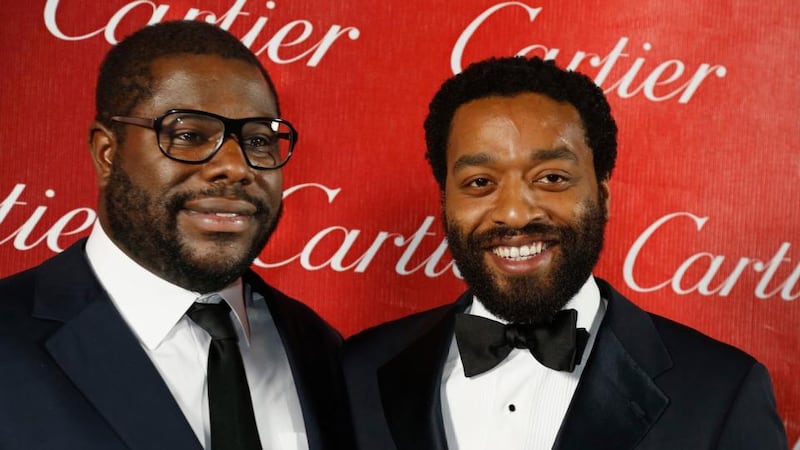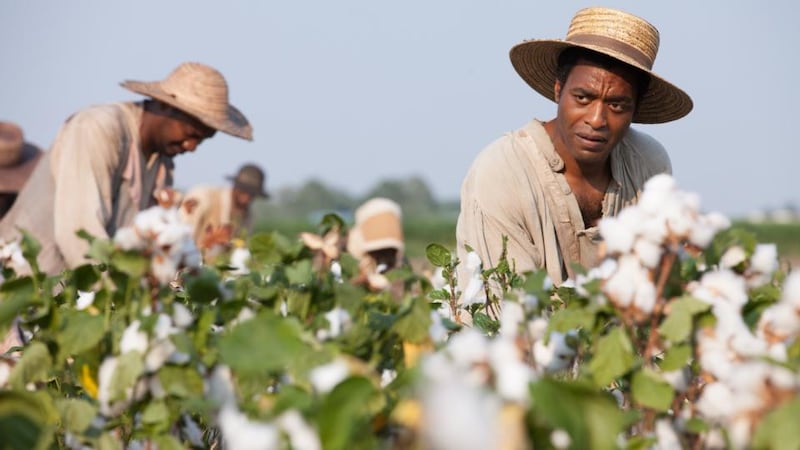Solomon Northup was a violinist living with his wife and two children in upstate New York when, in 1841, hired goons kidnapped and transported him to America’s Deep South, to be sold into slavery. Northup’s story was previously adapted for US TV in 1984 when Deep Space Nine’s Avery Brooks brought booming nobility to the central role.
But utilising the same probing tableaux and patient grammar that defined his previous feature films, Hunger and Shame, director Steve McQueen, along with leading man Chiwetel Ejiofor, has composed a very tactile masterpiece from Solomon Northup's historical ordeal. The film, 12 Years a Slave, is currently the bookies' favourite to sweep this year's Oscars. Even before its release on this side of the Atlantic, it's the biggest splash of Ejiofor's already illustrious career.
“Historically, there was a gap between the end of the slave trade and the end of slavery,” says Ejiofor. “In Europe, that was a gap of 30 years; in America it was a gap of 60. It’s curious to think that people can conclude that the trade was wrong but that people could still be slaves. But that’s what was thought.


“So in the south, when it was no longer possible for slavers to get slaves from Africa, they took to other methods, either by taking slaves illegally from Africa or by kidnapping from the north of the country. And that’s the situation Solomon found himself in.”
As ever with McQueen, the devil is in the details. The film’s coruscating depiction of a near-hanging has been named by the Alliance of Women Film Journalists as 2013’s most unforgettable moment’. Even the chains on screen are the real deal.
“The props department found chains that were actually used in the period,” Ejiofor says. “And I asked for them well before they were needed, well before the beginning of the film. I had them in my trailer and I remember looking at them and thinking they were strange. Because although they were padlocked, there was an interlinking chain, so it looked as if you could twist them a certain way and you would be released. And when I put them on, that’s when I realised that’s always going to be the first reaction to being in that moment. You’re aware that you can’t smash them. But you’re thinking that there must be a way out. If you can only just think of it.”
McQueen’s flair for authentic detail extended to the location. 12 Years a Slave was shot at four historic antebellum plantations: Felicity, Magnolia, Bocage, and Destrehan, not far from the Louisiana cotton farm where Northup was enslaved, and just down the road from Evergreen Plantation, where Tarantino shot Django Unchained.
“It felt like we were dancing with ghosts. Definitely,” says Ejiofor. “At times it felt like being very close to something that you wondered if you wanted to fully see. My thing became wanting to get close enough to the history and place that I could feel something, feel what the experience would have been like – but without being overcome by that feeling. That was available in Louisiana, where there are slave huts and slave-hut museums where these events occurred. You can reach out and touch history. And you have to be careful that doesn’t become obsessive or disabling. It can only enter your soul a little bit.”
Despite the weight of history and the wrenching nature of the material, the cast and crew pulled together to ensure the shoot was not an ordeal.
"It was a very social set. We had dinners to welcome new arrivals and dinners to say goodbye when people left. Because we had a lot of cast members like Michael Fassbender and Benedict Cumberbatch, who are very in demand, we all went out to hang out in New Orleans together. And that became part of the experience. We weren't just trying to sit on an emotion and hit the beats. We were able to get to know each other and then come back to a scene and use those interactions. If we had held on to those emotions between takes we would have been exhausted and beaten up by the end of the shoot."
How did the actor’s background – he’s British-born to African parents – affect his approach to the material?
“I never felt separated from the slave experience in a way that some people might assume because my family are not from America or the West Indies,” he says. “I have family in Lagos. And as soon as I was conscious I was aware of slavery and of slavery involving Africans, Nigerians and the Igbo population. This story is set in Louisiana and it is an American story. But it also has an international element. It reflects a diaspora and a broader history of despicable deeds.”
Current news stories about slavery, involving nail bars, prostitution and a cod-Maoist sect in Brixton lend 12 Years a Slave an unexpectedly modern sheen. The film arrives hot on the heels of the slavery dramas Lincoln and Django Unchained, but Ejiofor doesn’t see this as a trend. One might equally look, he suggests, at American cinema’s current vogue for racially themed drama, notably Fruitvale Station, The Butler and Blue Caprice.
“I have a suspicion that Lincoln, Django Unchained and our film are much more coincidental than people think. I think Lincoln is centred around the end of slavery and the civil war as a way of exploring the man. It’s a frame for his heroism. Django is this extraordinary western that talks about slavery at an angle. These movies are not influenced by each other. We ended up shooting some of our film at the same time as Django. But Steve and his wife, Bianca, have been working on our film for a long time.
“Other films like The Butler and even Mandela – these films feel as though they are exploring something about black history, obviously, but also certain gaps in cinema representation. Maybe because of the president, maybe it’s an era of reflection, but people do seem readier to embrace those issues than they were before.”
In person, Chiwetel Ejiofor is every inch a movie star: polished, Vogue-shoot handsome, neat to the last shirt button. A scar, dating from a 1988 car crash, is visible on the actor’s forehead; the same collision killed his father. It’s easy to forget that he has spent most of his career on stage, not on screen.
Ejiofor was born in London in 1977 to Nigerian parents: his father was a doctor and his mother was a pharmacist. His younger sister is a financial correspondent for CNN. How did such scientifically minded parents end up with show-business oriented offspring?
“They were both scientific and artistic,” says Ejiofor. “My father was also a musician. My mother sang with him. His mother did backing vocals. So there was always a creative streak in the family. And as I was growing up, music was a very important part of my life.
“Acting kind of caught me in a slightly different way. I found it a really interesting way of self-expression without necessarily being too exposed. You’re always protected through the reflection of someone else, even if you’re really always talking about yourself. It’s not as naked as being a musician.”
As a teenager, Ejiofor joined the National Youth Theatre and was accepted into the London Academy of Music and Dramatic Art. He left after a year when Steven Spielberg came a-calling with a role in Amistad (1997). It was, the young actor imagined, a fortunate one-off.
“I thought it was very simple,” he says. “I had a very happy jaunt to LA at 19. And I imagined it would make a great story or memory. But I wasn’t going to stick around because I really wanted to do plays. And I was very definite and forthright about that. I left LA as soon as Amistad was done. I shook hands and headed home. I wanted to work in the National Theatre and the RSC.”
He has, despite these intentions, gone on to forge one of cinema’s most fascinating careers. He is, almost invariably, the best thing in every film he appears in: as a drag queen in Kinky Boots; chasing after Angelina Jolie in spy caper Salt; issuing dire warnings in Roland Emmerich’s €560 million hit, 2012.
There have been clever career choices with cult followings: Alfonso Cuarón’s Children of Men; Joss Whedon’s Serenity; and David Mamet’s underrated martial-arts drama, Redbelt. He has worked with many name directors, including Spike Lee (Inside Man), Ridley Scott (American Gangster) and Woody Allen (Melinda and Melinda). But it took Stephen Frears and the Oscar-nominated Dirty Pretty Things to bring Ejiofor around to the medium.
“That film allowed me to see and appreciate the poetic and artistic aspects of film-making that I hadn’t been aware of before. Suddenly I wanted to learn more. Stage craft is eight shows a week, following patterns and hitting the back of the room. It’s technical. It’s entering and exiting and blocking around your fellow actors. On film, it’s different. It’s trying to connect to something very interior, something that’s much more you, in a way.
“The acting muscles may all work in tandem. But they are very different muscles.”












